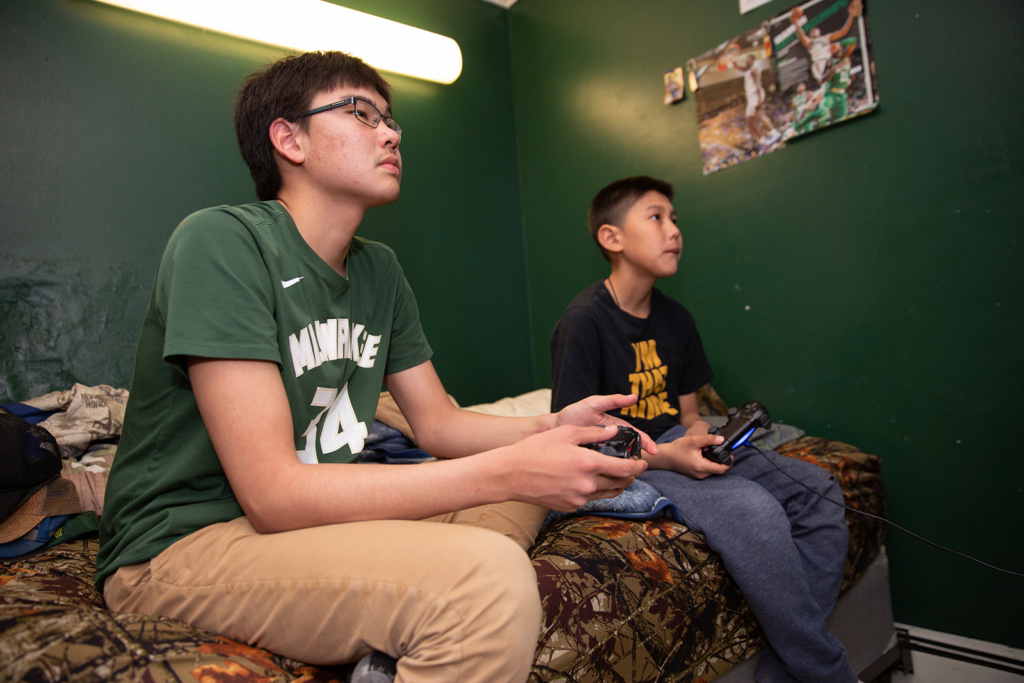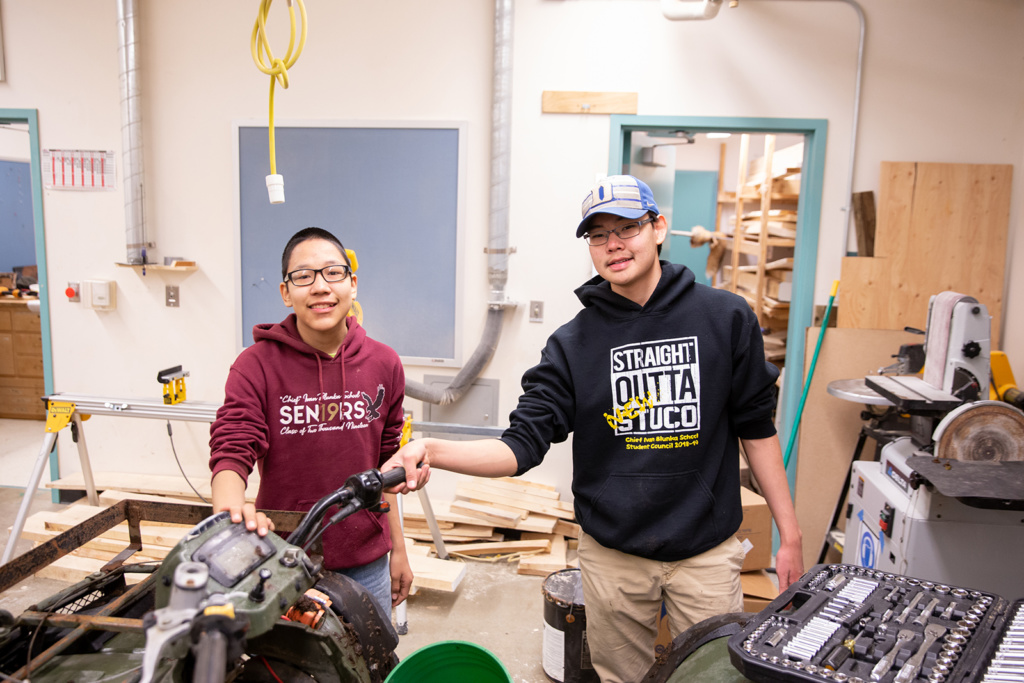Helmets On part 1: Community of New Stuyahok shaken following near-fatal crash
December 9, 2019
New Stuyahok sits on the quiet, rolling hills above the Nushagak River in the Bristol Bay region of southwest Alaska.
Like many rural areas in the state, New Stuyahok residents rely on skiffs, snowmachines and all-terrain vehicles (ATVs) for their subsistence hunts and day-to-day travel within the community. There are trucks in New Stuyahok, but they are about as rare as tall trees on the tundra.
As the hunting seasons change, so too do the ways residents reach these lands. On one fateful spring day, the tight-knit Yup’ik community’s attention had shifted from winter trapping and roaming caribou to the flocks of ducks and geese flying overhead to make their return north.
It is Honda season, a common term across Alaska in reference to ATVs. With the increasing daylight, Hondas are used more frequently and later into the evening. On sunny days, tires kick up dust on the roads like steam rising out of a maqii (steam bath). When it rains, water pools in potholes, creating a plane of miniature mud lakes. These road conditions and visibility are safety concerns when it comes to riding a Honda.
Road conditions and visibility are not the only concerns. Following an ATV crash felt by the entire New Stuyahok community on graduation day 2018, Tribal leaders and the Chief Ivan Blunka School partnered with Alaska Native Tribal Health Consortium to bring ATV safety and helmet education to the entire student population, kindergarten through 12th grade.
Everything can change in the blink of an eye
Jared Hanson loves the outdoors. One of seven boys, his family relies on subsistence hunting and fishing. The Hansons pack four freezers with moose, caribou, salmon, white fish, waterfowl and berries.
“My favorite things to do are hunting, fishing, trapping,” he said. “Being outdoors makes me happy.”
In his shop class, he made a mount for the antlers from his first caribou. They were too big to put in the living room, another rack already on display in the Hanson house, so they sit on his bedroom dresser until a more permanent spot is determined.
The rack glows in the light coming in through Jared’s bedroom window while he sits on the edge of his bed playing the video game NBA2K with his younger brother, Joel.
Like many students in rural Alaska, Jared loves basketball.

“I couldn’t play basketball because [doctors] think I’ll hit my head and have another brain injury,” Jared said.
Standing about 6-feet tall with a slender frame, his favorite parts of the game are rebounding and scoring. Jared’s favorite National Basketball Association player is Giannis Antetokounmpo and follows his team, the Milwaukee Bucks.
“How’d the Bucks do last night?”
“They won,” he said, flashing a shy smile. “Giannis had 29,” in a win against the Boston Celtics.
Last season, Jared was not able to shoot hoops with his high school teammates. He didn’t get to chase down rebounds after missed shots. He was limited to watching the Chief Ivan Blunka Eagles from the sidelines and only playing the video game version of the sport. But he wasn’t sidelined because of bad grades or behavior.
No, Jared was in a near-fatal ATV crash that left him with severe injuries, shaking his family and the entire community.
“I couldn’t play basketball because [doctors] think I’ll hit my head and have another brain injury,” Jared said.
He is lucky to be alive.
In May 2018, after his schoolmates walked for graduation at the Chief Ivan Blunka School, the then-10th grader sneaked out for an evening joyride with the family’s ATV. His parents, John and Gloria Hanson, were in Anchorage and scheduled to fly home on Sunday morning.
“We were going to come home but it happened right about 2 a.m. in the morning,” John said. “My boy Erick called us.”
Gloria is a Community Health Aide/Practitioner (CHA/P) in New Stuyahok. She got a call from a coworker at the clinic when Jared was brought in.
“He was badly hurt, he had a wrist fracture. I’m not sure if they knew that he might have had or he had a brain injury,” Gloria said. Judging by the way Jared was responding over the phone at the clinic, Gloria’s years of experience as a health aide indicated more, “First thing I thought was with those symptoms… I knew that something was going on with his head.”
Jared was medevaced to the Alaska Native Medical Center for care.
“The condition we saw when Jared was in the hospital was pretty intense,” his father said. “When we got there, he was all bruised up, swollen. He had a lot of cuts on his facial area, side of his ears. It didn’t look good.”
The medical staff at ANMC said that Jared’s prognosis was 50-50 chance of improvement, according to John. Doctors said it would be a day-by-day process for recovery.
“It was something that parents really don’t want to hear, especially from a doctor,” John said. “We started praying every day that he’d pull through.”
The crash left Jared with a traumatic brain injury, a fractured wrist, loss of vision in his right eye, facial fractures and difficulty with speaking, talking and swallowing. The traumatic brain injury was so severe he lost consciousness and was put on a ventilator for several days to help him breathe. He suffered from brain swelling and bleeding.
He wasn’t wearing a helmet during the crash.
“That first week was tough,” Gloria said. “It took him a week to come out of the coma.”
“I got up and freaked out,” Jared said. “I thought I was asleep for a week but then I [woke] in the hospital. I saw the light of the hospital.”
He was in the ANMC Intensive Care Unit for two weeks.
“We are very fortunate that we met you, Danielle, Dr. Glen, Dr. Glenn Stryjewski and all the other great providers there at ANMC!” Gloria Hanson wrote to Susan Romero the Pediatric Critical Care Nurse Practitioner who cared for Jared and the family during their pediatric critical care stay. “Thanks to all of you for taking care of Jared!”
With return visits and four different operations for his traumatic injuries, he spent about two months in and out of the hospital.
Long road to recovery
After being released from ANMC, Jared and his family traveled to Seattle, Washington for a full week of rehabilitation.
Due to his injuries, John Hanson said his son lost a lot of muscle and coordination in the months after the crash. Only 16 at the time, Jared’s age and athleticism made a difference in his physical recovery. After a full year of rehabilitation, he’s regaining coordination and strength.
“He’s really improving… we’ve seen a lot of changes, especially with his balance and speech. His strength, too, he’s on 25-pound weights now,” John Hanson said as he mimes an arm curl.

However, Jared’s brain injuries have had lingering effects on his memory and other function.
“[Jared’s] brain swelling affected how he interacts with the world and has affected, not only his memory, but also his day-to-day function,” said Dr. Elisha Brownson, Trauma Medical Director at Alaska Native Medical Center.
Because of this, he requested to join Ben Griese’s special education class at the Chief Ivan Blunka School in New Stuyahok. Griese recalls an early instance that showed how far Jared needed to rehabilitate his memory.
“I still remember the very first day of school. We gave him a piece of paper, which was his schedule, and we asked him, ‘Please deliver this [to a teacher].’ He grabbed it said, ‘OK,’ walked five feet and said, ‘What am I doing right now?’” Griese said.
In Griese’s class, he’s been able to focus on regaining his memory through brain games, puzzles and activities. The 17-year-old has accepted that he will likely have to think and learn differently than he did before the crash. But through his work with Griese, Jared’s recovery signs have been positive.
“Throughout the year, he has gone from forgetting what he was doing five seconds ago, to actually making large gains in his district assessments in measures of annual progress,” Griese said.
Jared’s mental assessment scores have jumped by double-digit points and has gotten to a point where he occasionally helps remind his teacher of things.
“Jared doesn’t have the mentality to quit,” Griese said.
For ATV safe riding and planning with TRIPSS, visit www.anthc.org/HelmetsOn.










